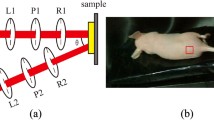Abstract
In order to understand the normal and pathological physiologies of the epidermal cells, the simultaneous determination of several elements in the different cellular strata is of crucial importance. In recent years the electron microprobe (EMP) has become an established technique in this field. Its high spatial resolution, in principle, allows measurements of various cell organelles. However, the limited (intrinsic) sensitivity of the EMP represents a serious drawback to the technique. The introduction of the proton microprobe (PMP) has significantly improved the sensitivity, although the ultimate spatial resolution of the PMP is much less than that of the EMP.
When studying the elemental profiles in skin epidermis, it is possible to use skin sections with a thickness of the order of 10 μm, then the spatial resolution of the PMP is equal to or better than that of the EMP since the electrons are scattered to a significant degree in the sample. The characteristics of the two methods have been compared by analysis of parallel duplicate freeze-dried sections of normal human skin. The distributions of the elements P, S, Cl, and K, obtained with the two techniques, were in good agreement. In addition, the PMP provided distributions of the important elements Ca, Fe, and Zn.
In a recently started study, the useful features of the PMP will be used for studying how efficient a barrier the skin is to nickel and chromate ions. A preliminary experiment has been performed by exposing cadaverous skin, not older than 24-h postmortem, to solutions of the two ions. After an 18-h exposure, samples were prepared by shock-freezing and sectioning. The first results from PMP analysis of these samples demonstrate the presence of a nickel and chromium gradient in the outer strata in the epidermis (mainly stratum corneum).
A third experiment deals with the physiology of psoriatic skin. Calcium is an important element in the differentiation. Hence, the higher sensitivity of the PMP has been used in analysis of sections from psoriatic skin epidermis. Preliminary results are presented.
Similar content being viewed by others
References
W. Gebhart, H. Ebner, and E. Erlach,Proc. 6th Eur. Congr. on Electron Microscopy, Jerusalem (1976) 226.
X. Wei and G. M. Roomans, inX-ray Microanalysis in Biology, M. A. Hayat, ed. Baltimore University Park, 1980, 401.
M. Lindberg, B. Forslind, and G. M. Roomans,Scanning Electron Microscopy, III, 1983, 1243–1247.
B. Gonsior, W. Bishof, B. Raith, A. Stratmann, and H. R. Wilde, inX-ray fluorescence in Medicine, R. Cesareo, ed., Field Education, Italia, Rome, 1982, 125–152.
K. G. Malmqvist, L.-E. Carlsson, K. R. Akselsson, and B. Forslind,Scanning Electron Microscopy, IV, 1983, 1815–1825.
B. Gonsior, this volume.
G. M. Roomans,Scanning Electron Microscopy, II, 1981, 345–356.
B. Forslind, L. Kunst, K. G. Malmqvist, L.-E. Carlsson, and G. M. Roomans,Histochemistry,82, 425 (1985).
D. Heck and E. Rokita,Nucl. Instr. Meth. Phys. Res. B3, 259 (1984).
K. Themner and K. G. Malmqvist,Nucl. Instr. Meth. Phys. Res. B15, 404 (1986).
S. T. Boyce and R. G. Ham,J. Invest. Dermatol. 81, suppl. 33s–40s, (1983).
H. Hennings, K. A. Holbrook, and S. H. Yuspa,J. Invest. Dermatol. 81, suppl. 50s–55s, (1983).
K. G. Malmqvist, L.-E. Carlsson, B. Forslind, G. M. Roomans, and K. R. Akselsson,Nucl. Instr. Meth. Phys. Res. B3, 611 (1984).
D. Heck and E. Rokita,IEEE Trans. Nucl. Sci. NS-30, 1220 (1983).
F. Watt, G. W. Grime, and J. Takacs,Nucl. Instr. Meth. Phys. Res. B3, 599 (1984).
W. F. G. Tucher, S. MacNeil, S. S. Bleechen, and S. Thomlinson,J. Invest. Dermatol. 82, 298 (1984).
Author information
Authors and Affiliations
Rights and permissions
About this article
Cite this article
Malmqvist, K.G., Forslind, B., Themner, K. et al. The use of PIXE in experimental studies of the physiology of human skin epidermis. Biol Trace Elem Res 12, 297–308 (1987). https://doi.org/10.1007/BF02796687
Issue Date:
DOI: https://doi.org/10.1007/BF02796687




